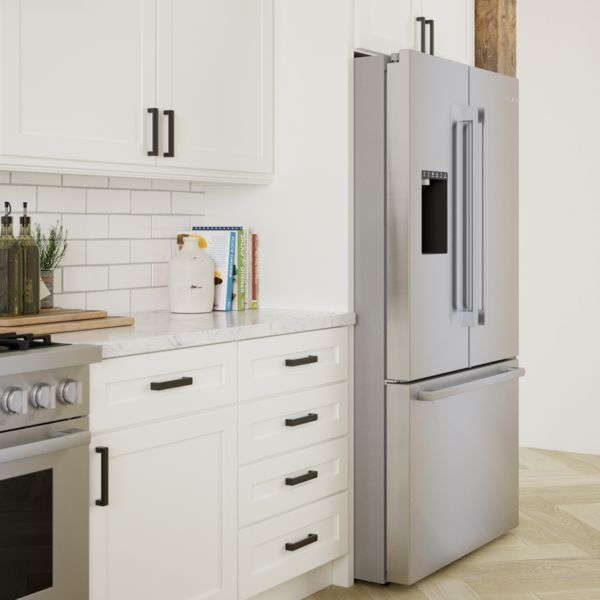At Bosch, we pride ourselves on delivering our customers top-notch kitchen appliances and valuable insights on products so they can make the best choice for to address their specific wants and needs. Today, we'll be diving into the world of counter depth refrigerators, explaining what they are and why you might choose one over a standard depth fridge.
Key Differences: Counter-Depth vs. Standard Depth

Standard Depth Refrigerators
Standard depth refrigerators, typically ranging in depth from 28 to 34 inches, are the most prevalent type of refrigerators in many households. These units are designed with maximum storage capacity in mind. Ideal for larger families or those who like to stock up, these refrigerators can accommodate bulkier items with ease. While they offer generous storage, they usually extend past the standard cabinet depth, and this protrusion can sometimes disrupt the cohesive look of a kitchen.
Standard Depth Pros:
1. Maximum Storage: Their larger depth allows for more storage space, making them ideal for households that require more food storage or like to buy in bulk.
2. Variety of Options: Given their prevalence, there's a wide variety of models, features, and price points available.
3. Accommodates Larger Items: Their increased depth can easily accommodate larger trays, platters, or bulkier items.
4. Cost: Many standard depth models can be more affordable than their counter depth counterparts, offering good value for the storage provided.
Standard Depth Cons:
1. Protrusion: They extend beyond standard cabinet depths, which can disrupt the look and feel of a kitchen.
2. Space Consumption: They can take up more floor space, which might not be ideal for smaller kitchens.
3. Potential for Waste and Clutter: The deeper shelves can sometimes lead to items being pushed to the back and forgotten, leading to potential waste.
4. Aesthetics: They might not offer the sleek, built-in appearance that some homeowners desire.
5. Accessibility: Deeper shelves might make it harder for some people to reach items placed in the far back.

Counter Depth Refrigerators
Counter depth refrigerators are designed to closely align with the depth of kitchen countertops. These units typically fall within a depth range of 23 to 27 inches, which is slightly shallower than the standard refrigerator depth and offers a more streamlined appearance compared to the standard models.
Counter Depth Pros:
1. Aesthetic Appeal: Their flush design and alignment with countertops provide a sleek and modern appearance, enhancing the overall look of the kitchen.
2. Space-Saving: They don't protrude into the walking or working area, making them ideal for kitchens with limited space or where a seamless look is desired.
3. Versatility: Suitable for a variety of kitchen layouts and designs, they are a popular choice for homeowners looking for a blend of aesthetics and functionality.
Counter Depth Cons:
1. Reduced Storage: While they provide sleek alignment with countertops, their storage capacity might be slightly less than that of standard depth models.
2. Price: They can sometimes be pricier than some standard depth models, but the added aesthetic value often justifies the cost for many homeowners.
Looking for quality counter depth refrigerators? Check out Bosch’s high-end refrigerator options here.
Bosch Counter Depth Refrigerator Features
Many Bosch counter depth refrigerators come with a range of features to improve your kitchen experience. Innovative features included in some Bosch fridges are:
- VitaFresh® technology: Keeps food fresh up to 3x longer* with precise humidity and temperature controls. It balances both temperature and humidity levels based on the food setting, ensuring optimal freshness for various food items.
- QuickIce Pro System™: Known as the industry’s fastest refrigerator ice maker, it offers freshly filtered ice and replenishes quickly. This system can produce up to 12 lbs. of ice per day.
- UltraClarityPro® water filter: This feature reduces more than 99.9% of impurities found in water and ice, including elements like chlorine and chloramine.
- Refreshment Center™: A special refrigerator section with an easy-to-view, easy-to-reach glass display drawer. It comes with pre-programmed settings for optimal temperature control for various beverages, from craft beer to wines and juices.
- ENERGY STAR® certification: All Bosch refrigerators are ENERGY STAR® certified, making them about 9% more energy efficient than models that only meet the federal minimum energy efficiency standard.
- Home Connect®: This feature allows you to remotely monitor and control your Bosch refrigerator from your smartphone. You can adjust the temperature and other settings from wherever you are.
How to Make Sure Your Refrigerator Will Be the Perfect Fit

Importance of Accurate Measurements
When it comes to kitchen appliances, precision is key. Ensuring accurate refrigerator dimensions not only guarantees a perfect fit but also ensures efficient use of space and optimal airflow.
1. Measure Your Kitchen Space:
- Width: Measure the width of the space you plan to install the refrigerator at the upper cabinet, countertop, and base levels. Always measure the space at its narrowest points to ensure a good fit.
- Height: Measure the height of the space from the floor to the lowest point on the upper cabinet. Make this measurement twice, first at the front of the space and then at the back. If there's a difference, use the shorter of the two measurements.
- Depth: Measure the depth from the back wall to the front edge of your counters.
- Clearance: If you have a kitchen island, ensure there's enough distance between the island and the counters adjacent to the refrigerator for delivery and daily use.
2. Measure the Ventilation Space: Air circulation is crucial for the efficient operation of your refrigerator. Ensure there's a minimum clearance of 2 inches from the back wall, 1 inch from the upper cabinet, and 1/4 inch on either side of the fridge. Always check the manufacturer's recommendations and adjust your measurements accordingly.
3. Measure the Refrigerator Dimensions: When shopping, take note of the height, width, and length of the refrigerator. Be sure to check the measurements of the refrigerator's doors. Consider the angle of the door outswing and the path of any freezer drawers. Ensure there's enough room in front of the fridge for the doors to open fully, and that they won't obstruct any adjacent cabinets, islands, walls, or hallways. The measurements for most refrigerators are usually listed for you.
- For example, Bosch’s 800 Series French Door Bottom Mount Refrigerator provides a required cutout size of 72” x 36” x 25”, so you can know you have an exact fit.
4. Measure the Delivery Path: Before finalizing your purchase, plan the path from the delivery truck to the refrigerator's final location. Choose the most direct route with the fewest obstructions. Measure doorways, hallways, and any other tight spots the refrigerator will need to pass through. In some cases, doors may need to be removed for delivery.
What Counter Depth Refrigerator Styles Are Available?
Counter depth refrigerators have gained immense popularity due to their sleek design and space-saving features. As a result, manufacturers have introduced a variety of styles to cater to different aesthetic preferences and functional needs. Here are some of the most popular styles available:
1. French Door Counter Depth Refrigerators: This style features two doors on the top section for the refrigerator and a bottom freezer drawer. It offers easy access to both the fridge and freezer sections and is known for its stylish appearance.
2. Side-by-Side Counter Depth Refrigerators: In this design, the fridge and freezer sections are placed next to each other, offering ample storage space and easy access to both sections. This style is particularly beneficial for kitchens with limited space as the doors require less room to swing open
3. Bottom Freezer Counter Depth Refrigerators: With the freezer located at the bottom, this design prioritizes the refrigerator section, placing it at eye level. It's ideal for those who access the fridge more frequently than the freezer.
4. Top Freezer Counter Depth Refrigerators: A more traditional style, the top freezer design places the freezer section above the refrigerator. It's a compact solution and often comes at a more affordable price point.
5. Column Counter Depth Refrigerators: These are single column units that can be either a refrigerator or a freezer. Homeowners can mix and match based on their needs, allowing for a customized kitchen layout.
Use a Standard Depth Fridge with the Counter Depth Look for the Best of Both Worlds
For homeowners who desire the spaciousness of a standard depth refrigerator but don't want to compromise on the sleek, counter-depth appearance, there are several solutions. By using cabinetry panels and strategic placement, you can achieve a streamlined look with a standard depth fridge.
1. Cabinetry Panels: Custom cabinetry panels can be attached to the front of a standard depth refrigerator, allowing it to blend seamlessly with the surrounding cabinets. This not only gives the fridge a built-in appearance but also elevates the overall design of the kitchen.
2. Surrounding Cabinetry: Building cabinetry around the refrigerator can also give it a counter depth look. This method provides additional storage space and ensures that the fridge fits perfectly within the kitchen's design.
3. Recessed Wall Placement: Another method is to recess the refrigerator into the wall, so only a small portion of it protrudes into the kitchen space. This method requires careful planning and might involve some construction, but the result is a standard depth fridge that looks and feels like a built-in unit.
Want to learn more about how to choose the perfect refrigerator? Check Bosch's Comprehensive Guide on Refrigerator Buying.
FAQs
Answer: Cubic feet is a volume unit used to measure the internal capacity of a refrigerator, indicating how much space is inside for storing food and beverages.
Answer: The cubic feet is typically listed in the product specifications. If not, calculate it by multiplying the width, height, and depth of the fridge's interior. Convert all measurements to feet before multiplying.
Answer: Consider the size of your household, shopping habits, and kitchen space. Larger families or bulk shoppers might prefer a larger capacity, while smaller households or those with space constraints might opt for a compact size.
Answer: Typically, a 2-inch clearance from the back wall, 1 inch from the top, and 1/8 inch on either side is recommended. Always check the manufacturer's guidelines.
Answer: Built-in refrigerators are usually counter depth, and are designed to fit seamlessly into kitchen cabinetry, providing a streamlined and integrated appearance. These units are anchored to a wall within the cabinets for a more permanent installation, distinguishing them from traditional freestanding models.



